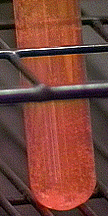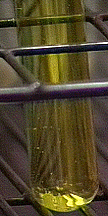| |
Lab Activity
3.2
Photosynthetic Pigment Extraction
|
|
|
|
Directions
|
|

|
Study
the instructional material below. Be sure to click on each of the photographs
for an enlarged view in a separate window. The
larger version is necessary to complete the assignment.
It opens in a separate window which can be resized by grabbing the bottom
right corner and dragging it. It
can also be moved by
grabbing the top heading bar and dragging it.
Be sure to close the extra window by using the X in IBM, or the close box
in MAC when you are finished using them. |
|
|
Introduction
|
|

|
Seaweeds
contain a variety of colorful molecules that enable them to capture sunlight
energy for use in the food producing reactions called photosynthesis. These
light absorbing molecules are collectively called photopigments. All seaweeds
contain the green photopigment called chlorophyll which is central in photosynthetic
reactions. Most seaweeds contain additional photopigments called accesory
pigments. Accessory pigments vary in color from yellow to orange to red
which provide their owners with a variety of hues other than the emerald
green of chlorophyll. Phycobilin is an example of an accessory pigment found
in many of the Rhodophyta. |
|
 Instruction
Instruction
|
|

|
Study
the information, photographs, and video clips in the experiment that follows.
Be sure to complete the observations, formulate answers to the questions
you're asked, and write them in your notebook.
Be sure
to write about what you are learning in the lab section of your notebook.
You will be expected to answer questions about the lab activity during
the lab self test and lab quiz. It helps to have your text and coloring
books open beside you for support.
|
| |
| Supporting
Information |
| Refer
to the Assigned Readings Below: |
| Marine
Biology Textbook |
Chapter 4, pages
71 to 74
Chapter 6, page 109
|
| Marine
Biology Coloring Book |
None |
|
| |
Phycobilin
Pigment Extraction
The Rhodophyta are seaweeds
which contain phycobilin accessory pigments that give them their red color.
Phycobilins are water soluble and can be extracted by grinding up seaweed
in water. The phycobilin dissolves in the water creating an aqueous solution.
The phycobilin solution can then be purified by separating the particles
of seaweed from the water.
|
Aqueous Homogenate
Preparation:
- We put a sample
of coralline algae into a blender and added 30 ml of distilled
water.
- We blended the
seaweed at high speed for five minutes to produce an aqueous (water
based) homogenate.
|
|
Separation
of the Aqueous Homogenate:
- We poured the
homogenate into centrifuge tubes and
centrifuged the homogenate for four minutes at high speed (7,000
rpm) to separate the particles of seaweed from the aqueous (water
based) solution of phycobilin.
|
|
|
Phycobilin Pigment
Solution:
- We decanted about
75% of the water solution from each of the centrifuge tubes into
a clean glass test tube.
- We examined the
tube to observe the color of the phycobilin solution.
Observations:
- Observe the photograph
of the phycobilin solution and examine and describe its color.
|

|
Chlorophyll Pigment Extraction
Rhodophyta contain the
primary photosynthetic pigments, chlorophylls a and c. Chlorophylls are
insoluble in water and must be extracted with organic solvents such as
alcohol. The chlorophyll dissolves in the alcohol creating an alcoholic
solution. The chlorophyll solution can then be purified by separating
the particles of seaweed from the alcohol.
|
Alcoholic Homogenate
Preparation
- We discarded the
remaining water from the centrifuge tubes containing the seaweed
particles retained from the aqueous extraction and added 10 ml
of 95% ethanol.
- We capped the
centrifuge tubes and shaked them vigorously for three minutes
to resuspend the seaweed particles and produce an alcoholic homogenate.
|
|
|
Separation of the
Alcoholic Homogenate
- We centrifuged
the alcoholic homogenate for four minutes at high speed (7,000
rpm) to separate the particles of seaweed from the alcoholic solution
of chlorophyll.
|
|
|
Chlorophyll Pigment
Solution
- We decanted about
75% of the alcohol from the centrifuge tubes into a clean glass
test tube.
- We examined the
tube to observe the color of the chlorophyll solution.
Observations:
- Observe the photograph
of the chlorophyll solution and examine and describe its color.
|

|
|
|
|
|
|

